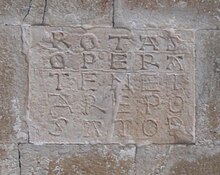
The Sator Square (or Rotas Square) is a word square containing a five-word Latin palindrome:
S A T O R
A R E P O
T E N E T
O P E R A
R O T A S
In particular, this is a square 2D palindrome, which is when a square text admits four symmetries: identity, two diagonal reflections, and 180 degree rotation. As can be seen, the text may be read top-to-bottom, bottom-to-top, left-to-right, or right-to-left; and it may be rotated 180 degrees and still be read in all those ways.
The Sator Square is the earliest dateable 2D palindrome. It was found in the ruins of Pompeii, at Herculaneum, a city buried...